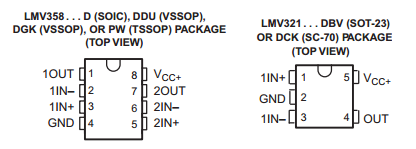Did you know that there are operational amplifiers (op amps) with a ground pin? If you’re an experienced analog engineer, you probably know that, but those who haven’t worked much with older op amps might be asking themselves, “What’s a ground pin?”
Integrated circuit (IC) manufacturers used to label the ground pin, which is supposed to indicate zero volts, “GND.” Today, manufacturers like TI label the pin on new op amps “V-,” or “N/C” (negative supply and no connect). This is because GND is supposed to indicate zero volts, but an op amp never puts out exactly zero volts, making the original label confusing.
The LMV321, LMV324 and LMV358, which are more than 20 years old, are good examples of amplifiers that still use the GND label. You will see in Figure 1, the LMV358 and LMV321 pinouts, including the GND label. The new and improved versions of these amplifiers (LMV321A, LMV324A, and LMV358A) no longer use the GND label.
Figure 1: Top view of the LMV358 and LMV321 pinout showing the ground pin
Besides the rare examples, like the ones I mentioned above, it seems the ground pin label has disappeared altogether, at least in op amps. The old GND label gave way to appellations such as “single supply,” which can also be misleading. Does “single supply” mean you cannot use the amplifier in a split-supply fashion? Of course you can, as long as you don’t violate your device’s common-mode input range. But many engineers who are not accustomed to designing with older op amps might not know this.
A shortcoming of the single-supply op amp is that it can only accept positive voltages (at most a few hundred millivolts below ground) and produce positive voltages at its output. The “single supply” label was meant for devices targeted at high-volume, low-cost consumer applications. After all, an additional negative power supply adds additional cost.
Many options exist to get a true zero output without worrying whether there is a pin labeled GND. For a dual-supply design, consider switching regulators with dual outputs, such as the TPS65133 or the TPS65130, which will synthesize a dual supply. If your design uses just one positive power supply, consider a more cost-effective solution with the LM7705, one of my favorite true-zero-output generators. All three of these devices will enable you to get a true zero at the output of the amplifier.
Yet another option is to use the TLE2446 single supply with a rail splitter, which allows you synthesize a reference (mid-supply).
I would like to hear your comments about your experience with the GND pin. Log in and drop me a line below in the comments. Let me know why you think it was there in the first place.
Additional resources
- Learn more about amplifiers by watching TI’s on-demand training courses in TI Precision Labs
- Learn more about amplifiers by downloading the “Best of Baker’s Best Amplifiers” e-book by Bonnie Baker.
- Visit the Amplifier forum to learn more from other engineers.
- Download the “Analog Engineer’s Pocket Reference” e-book.
- Learn about TI’s entire portfolio of amplifier ICs and find technical resources.


-

james hardy
-
Cancel
-
Vote Up
0
Vote Down
-
-
Sign in to reply
-
More
-
Cancel
Comment-

james hardy
-
Cancel
-
Vote Up
0
Vote Down
-
-
Sign in to reply
-
More
-
Cancel
Children